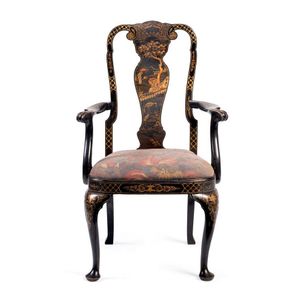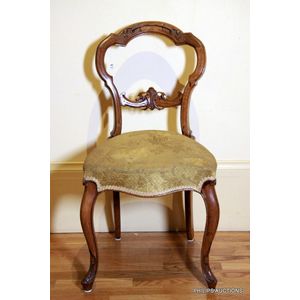Chinoiserie Elbow Chair, George III, 1790
You must be a subscriber, and be logged in to view price and dealer details.
Subscribe Now to view actual auction price for this item
When you subscribe, you have the option of setting the currency in which to display prices to $Au, $US, $NZ or Stg.
- George Iii - George III (1738 - 1820) was King of Great Britain and Ireland from 1760 to 1820.
- Chinoiserie - Furniture and decorative items decorated in imitation of a Western interpretation of the Chinese style. The Chinoiserie style first became popular in the late 17th century, though there were frequent revivals, notably by Chippendale (hence 'Chinese Chippendale') during the Regency period, and the Anglo-Japanese style in the second half of the 19th century.
The ubiquitous 'willow pattern' is the most common 'Chinese' theme used in porcelain, while on furniture the Chinoiserie style usually has black or red painted and lacquered decoration, though the hallmark of the furniture style is the use of fretwork in geometrical patterns, pagodas and other decorative forms.
Japonaiseries, as the name implies, are motifs in imitation of the Japanese taste.
See also "Chinese Chippendale". - Circa - A Latin term meaning 'about', often used in the antique trade to give an approximate date for the piece, usually considered to be five years on either side of the circa year. Thus, circa 1900 means the piece was made about 1900, probably between 1895 and 1905. The expression is sometimes abbreviated to c.1900.
- Drop in Seat - Mostly used on Regency upright chairs, a drop in (or "drop on") seat is an unsprung removable seat where the upholstery is attached to a wooden frame, which is held in place by the sides of the chair, and usually a wooden peg at the front of the chair. An inset upholstered seat is of the same construction, but it sits within a frame whose perimeter includes four sides of the chair.
Because the upholstery frame was not very deep, the seats were relatively uncomfortable. In the mid 19th century coiled upholstery springs came into use and frame of the chair was used as the upholstery frame, making for a much more comfortable and responsive seat.
This type of seat was known as an over-upholstered or over-stuffed seat. - Elbow Chair - Another name given to a dining chair with arms, more commonly called a carver chair.
This item has been included into following indexes:
Visually similar items

A black Chinoiserie lacquer armchair, English 19th century, 105 cm high, 60 cm wide, 52 cm deep

A set of eight quality early 20th century burr walnut Queen Anne style dining chairs, the set including six side chairs and two carver chairs, elaborate urn splat backs with carved pediment detail, scrolling bar supports, serpentine shaped framed drop-in s

A fine George I walnut open armchair, early 18th century, with scroll top-rail and drop-in seat, on cabriole legs headed with protruding scrolls

A set of four Victorian pale mahogany dining chairs, 19th century, the balloon back chairs with trefid crests carved with bud and clover designs, pierced vegetal motifs to the mid rails, stuffover seats and cabriole legs with pointed toes, height 89 cm, wi
